What’s the Best 61 Key Keyboard?
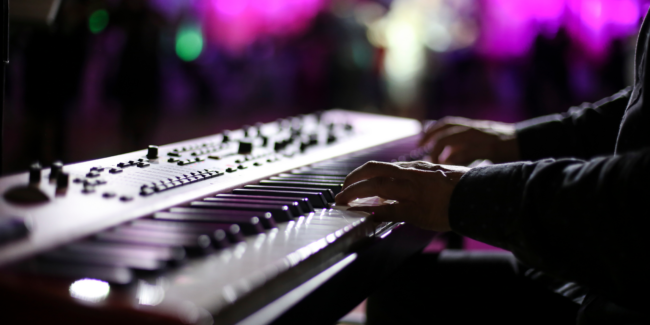
Looking for a 61-key keyboard that fits your budget and needs? Here are five of the best options, based on extensive research.
Many beginning piano students feel that they need a full-size 88-key piano before they can start practicing. However, keeping an open mind and exploring all your options is always a good idea.
A 61-key keyboard can be a great model for beginning students. Besides, five octaves are enough to play most contemporary songs.
The 88-key keyboards haven’t always been the norm. They became fashionable in the late 1800s. This means composers like Mozart, Bach, and Beethoven began their musical careers with as few as 60 keys on their pianos. So, if you decide on a 61-key keyboard, you’re in good company.
How to find the best 61-key keyboard for you.
To find the right 61-key keyboard for you, here are some technical specifications to consider:
Key action
Digital pianos tend to offer more realistic key action than keyboards. However, many keyboards on the current market are beginning to have better midi capabilities. These keyboards can mimic a piano’s dynamics. So the harder you press on the keys, the louder the sound. This key velocity is significant for beginning students learning to respect dynamic markings and play with feeling.
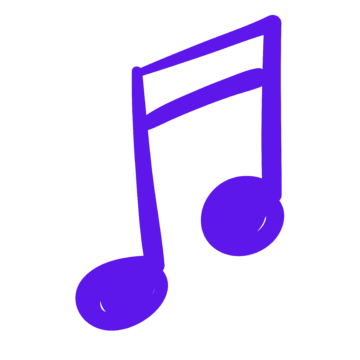
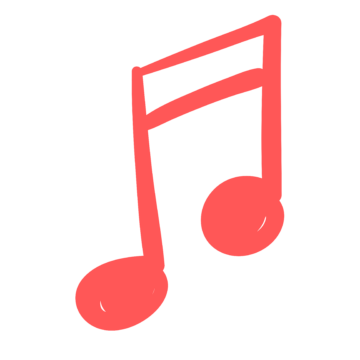
Recording capabilities
Do you want to become a songwriter? You might check into the input and output of your keyboard and check the internal storage capacity. An arranger’s keyboard that offers a host of sounds and recording features can be an excellent way to create scratch tracks.
Internal storage
How much internal storage does the keyboard have? Many keyboards allow you to record different practice sessions and then later play them. This is an excellent way to pinpoint difficult spots in your music. Then you can focus your energy on the trouble spots to improve your piece.


Sound
Many keyboards tell you how the sounds are sampled and embedded in a keyboard model. The higher the quality of the recording, the better the sound.
If you have the opportunity to try out a keyboard model live, then do it. This allows you to test the feel of a keyboard and see how it sounds for yourself. If you love to practice using different instrument sounds, you might choose a keyboard with a large variety of sound options.
Polyphony
Keyboards with higher polyphony allow you to play more notes and sounds simultaneously. For example, a keyboard with 88-note polyphony means that you can play 88-notes or sounds at once. Your polyphony count is entered by metronomes, layered sounds, chords, and background beats. High-quality keyboards usually have at least 128-note polyphony.
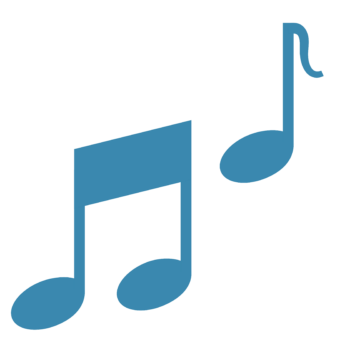
The five best 61-key keyboards on today’s market.
Best arranger’s keyboard: Yamaha PSRE373
- Keystroke velocity
- Duo mode
- Keyboard notes visual aid
- 622 instrument sounds
- Smart Chord
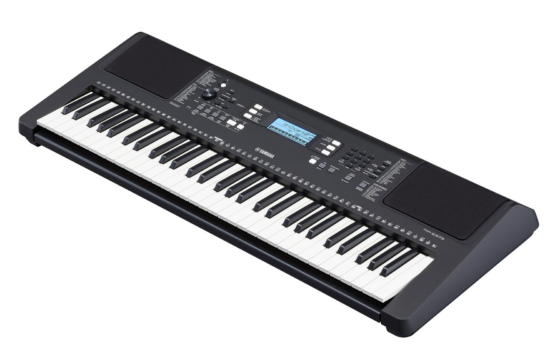
The Yamaha PSRE373 is our pick for the best 61-key keyboard overall. This arranger’s keyboard comes at an affordable price and has many great features.
It comes with keystroke velocity, meaning the keys are responsive to your touch and play loud or soft accordingly.
It also boasts 622 different instrument voices to keep your practice sessions interesting. You can split this keyboard in duo mode to play the same notes with a teacher or friend. Or, you can choose to use Smart Chord, which creates impressive sounding chords by pressing a few notes. The note names are also labeled unobtrusively over the keys. You can start learning note names while you play.
We love that this portable Yamaha keyboard has a nice touch, good sound, and several features which benefit you as you build your piano skills.
Best for beginners:
Casio LK-S250
- Lighted keys
- Touch response
- Built-in handle
- 400 tones
- 77 rhythms
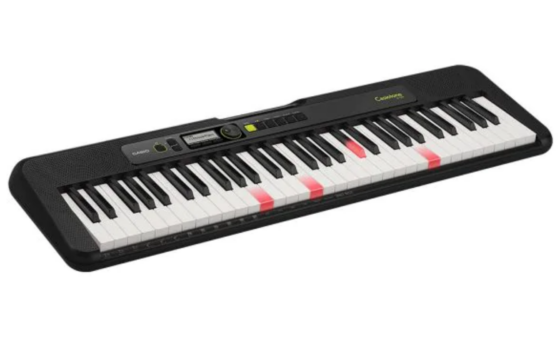
This lightweight keyboard allows you to take your music wherever you want. It even has a built-in handle, so it doesn’t get left behind. You can use the power supply or pop in AA batteries. This means you don’t have to worry about hunting up a plug when you want to play.
The keys are sensitive to your touch, so you can play some lovely, dynamic pieces. These keys also light up, training your eyes to find the right notes every time. The Casio packs 400 tones and 77 backup rhythms. You also get ten different types of reverb for a full sound. You can even compose your own Electronic Dance Music and go wild!
Once you find the combination of sounds and rhythms you like, you can save your preferences with the My Set-up button.
Best for sound:
Casio CT-X5000
- Full-size, touch-responsive keys
- 800 tones
- 235 editable rhythms
- USB-MIDI and USB device port
- Pitch bend wheel
- Pedal input
- Includes AC adapter
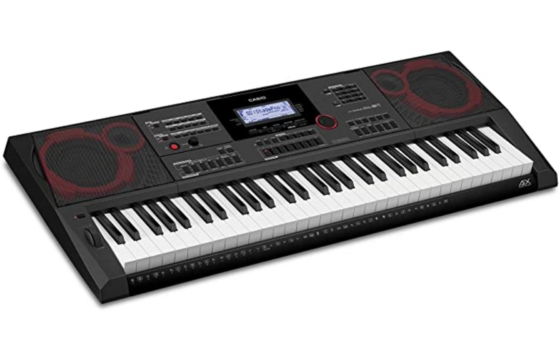
The Casio stands out among the competition for having an excellent sound in the 61-key keyboard gamut. The keys are full-size and weighted for that natural piano touch. The recordings for the grand piano and many other instruments embedded in this instrument have an amazingly realistic sound.
Also, the Casio CT-X5000 offers you various instrument recordings to choose from. With 800 tones, 235 rhythms, and a pitch bend wheel, you can experiment with your new Casio keyboard for quite a while.
This keyboard goes for over $400, making it one of the most expensive keyboards on our list. However, it does pack in a lot of great sounds.
Most compact:
Roland GO-61K
- User-friendly
- Compact size
- Loop Mix
- Bluetooth audio/MIDI support
- 500+ sounds
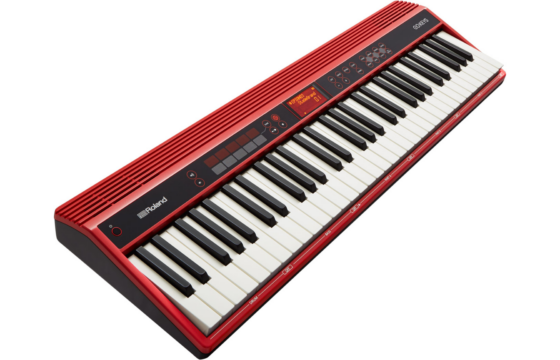
The Roland Go-61K is one of the most compact keyboards on the market. At only 11×35 inches, this model is easy to tuck into any corner of your house. This keyboard has a clean-looking display which is pretty straightforward to use. However, it is not lacking in features.
This tiny, red electric keyboard holds over 500 sounds in its repertoire. The loop mix feature gives you a full sound even when you only play a few notes. This is a nice feature, especially for beginning students. You can play simple tunes that sound great. That’s a nice boost to the confidence, which motivates you to work harder to stick those notes.
Best value:
RockJam 61-Key
- Traditional piano key-feel
- 200 tones
- 200 rhythms
- Battery option
- Record and playback
- Keyboard stand, piano bench, and headphones included
- Exclusive Simply content
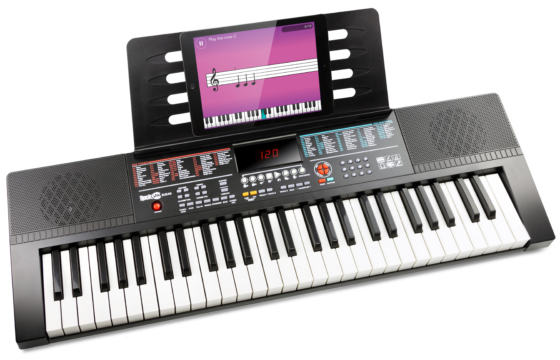
The RockJam Keyboard Piano Super Kit packs in great value for the price. This starter pack includes a keyboard stand, bench, and high-quality headphones. But that’s not all!
You’ll get access to exclusive Simply Piano content by purchasing this 61-key keyboard. There are plenty of tones and rhythms to keep you entertained and create your own masterpieces. The USB and AUX inputs let you accompany songs through your phone or an MP3 thumb drive.
If you want to take it on the go, you can pop in D-sized batteries so you can play your songs anywhere there is a crowd. The LED display allows you to choose different features such as record and playback, teaching modes, a metronome, split keyboard mode, and transposition.
Now that you’ve looked at a few of the top choices on the market, it’s time to see which 61-key keyboard is right for you. With the help of the Simply Piano app, you can build your skills. You can take your newfound skills and show them to the world with a small-scale piano. Let us know what keyboard is your favorite in the comments!









